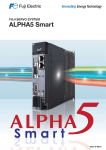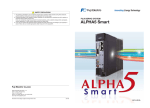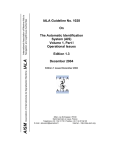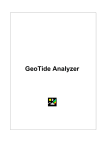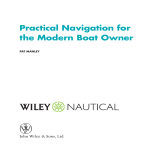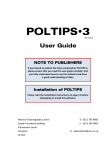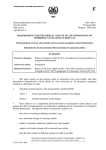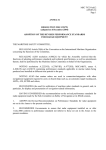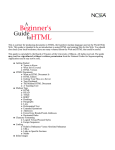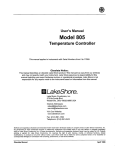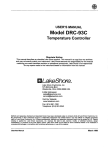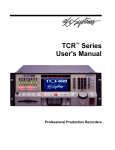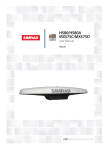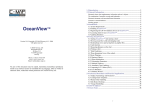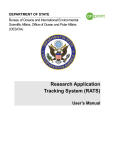Download csmwg15-10a
Transcript
INTERNATIONAL MARITIME ORGANIZATION E IMO SUB-COMMITTEE ON SAFETY OF NAVIGATION 50th session Agenda item 4 NAV 50/4 23 March 2004 Original: ENGLISH REQUIREMENTS FOR THE DISPLAY AND USE OF AIS INFORMATION ON SHIPBORNE NAVIGATIONAL DISPLAYS Report of the Correspondence Group for Presentation of Navigation-related Information Submitted by Germany SUMMARY Executive summary: Proposal on new Performance Standards for the Presentation of Navigation-related Information as well as a proposal for an SN Circular for the harmonization of symbols for the presentation of navigation-related information and a proposal for an SN Circular for the harmonization of terms and abbreviations. Action to be taken: See paragraphs 11 and 12 Related documents: MSC/Circ.982, SN/Circ.217, NAV 47/13, NAV 48/4/1, NAV 48/19, NAV 49/4, NAV 49/4/1 and NAV 49/19 Terms of reference 1 The Sub-Committee on Safety of Navigation at its forty-ninth session considered the outline for proposed performance standards for the presentation of navigation-related information (NAV 49 /4 (IEC)) and established a Correspondence Group to progress the work and to further develop draft performance standards. This work should include the addition of more detailed display requirements. The opinion of the Sub-Committee was that these new performance standards should take precedence over existing equipment performance standards when conflicts regarding presentation issues occur. 2 Furthermore, the Sub-Committee tasked the Correspondence Group to prepare a draft SN/Circ based on document NAV 49/4/1 (IEC) to harmonize terms and symbols used to present navigation-related information, including consideration of the differences between NAV 49/4/1 (IEC) and ISO standards and existing radar/plotting standards. For reasons of economy, this document is printed in a limited number. Delegates are kindly asked to bring their copies to meetings and not to request additional copies. I:\NAV\50\4.DOC NAV 50/4 -2- The work of the Correspondence Group 3 Members of the Correspondence Group included France, Germany, Japan, Norway, Poland, Sweden, United Kingdom, the United States, and the following non-governmental organizations: International Electrotechnical Commission (IEC), International Hydrographic Organization (IHO) and the International Organization for Standardization (ISO). 4 The Correspondence Group began with the structure of the outline for proposed performance standards ((NAV 49/4 (IEC)) and developed detailed requirements for the presentation of navigation-related information. The requirements are based on presentation requirements from existing performance standards (e.g. radar and ECDIS). For the sake of completeness some requirements were transferred from individual performance standards. This fact should be regarded in case of revision of individual performance standards. Detailed requirements for the presentation of AIS information were developed on the basis of SN/Circ.217. This work was conducted in close co-operation with the Correspondence Group on Radar. As a result the requirements for the presentation of AIS information are listed in the draft performance standards on Presentation of Navigation-related Information and the operational and functional requirements for the display of AIS target information are listed in the draft revised performance standards for Shipborne Radar equipment. Draft performance standards for the Presentation of Navigation-related Information are attached as annex 1. 5 The Correspondence Group started with document NAV 49/4/1 (IEC) and developed a proposal for harmonized symbols. The task was to harmonize navigational symbols, especially the symbols for own ship, radar targets and AIS targets. During development, the Correspondence Group considered the following: • Symbols should be based on symbology currently in use • Only minimum changes to existing symbols should be applied • New or modified symbols should be introduced only when needed • Symbols should be arranged into logical functional groups with a common base symbol • Symbol should be consistent between logical functional groups • The total number of symbols should be kept to a minimum • Symbols should be distinguishable by shape or outline rather than colour alone • Symbols should be designed using as few colours as possible Conflicts were identified in the presentation of several existing symbols. As a result, a consistent solution was determined for the presentation of the own ship symbol, radar symbols and AIS symbols. These three classes of symbols are discriminated by shape, e.g. radar symbols based on a circle, and AIS symbols based on an oriented triangle. For radar and AIS targets the functional state, e.g. danger state, is coded consistently by applying additional attributes to the base symbol. A draft SN Circular for the harmonization of symbols for the presentation of navigation-related information is attached as annex 2. I:\NAV\50\4.DOC -3- NAV 50/4 6 For safety reasons the terms and abbreviations used for the display of navigation-related information on all shipborne navigation equipment and systems should be consistent. Based on NAV 49/4/1 (IEC) and ISO standards, the Correspondence Group prepared a harmonized list of terms and abbreviations for use in the presentation of navigation-related information. The list was developed together with IEC and ISO experts and represents a concerted solution. A draft SN Circular for terms and abbreviations is attached as annex 3. Additional findings 7 Based on more practical experience gained with the onboard use of AIS, the Interim Guidelines for the Presentation and Display of AIS Target Information (SN/Circ.217) should be replaced by: • The presentation requirements from the draft Performance Standards for the Presentation of Navigation-related Information (attached as annex 1) • The functional requirements from the draft revision of the Performance Standards for Shipborne Radar equipment (NAV 50/9) • The symbology listed in the draft Guidelines for the Presentation of Navigation-related Symbols (attached as annex 2). 8 During the development of the draft Performance Standards for the Presentation of Navigation-related Information, the Correspondence Group noticed that definitions for common terms are often different in the various Performance Standards. For that reason the Correspondence Group recommends the development of guidelines for navigation-related definitions, which should replace the definitions in the individual Performance Standards. 9 During the development of the draft performance standards for the Presentation of Navigation-related Information, the Correspondence Group identified the lack of a common approach or organizational structure for navigation-related alarms and indications. For that reason the Correspondence Group recommends the development of guidelines for the management and presentation of navigation-related alarms and indications, which should include prioritisation for presentation. 10 It was further noticed that the existing performance standards for ECDIS contain some inconsistencies and are lacking in the area of the operational requirements for chart data processing. The Correspondence Group therefore recommends a review of the performance standards for ECDIS as well as the referring standards in order to clarify operational requirements and introduce new requirements for ECDIS. This may result in a recommendation to revise the existing performance standards for ECDIS. Actions requested of the Sub-Committee 11 The Sub-Committee is invited to consider and approve the following; .1 the draft performance standards attached as annex 1, recognizing their close relationship with the proposed revised performance standards for shipborne radar equipment; .2 the draft SN Circular on guidelines for the presentation of navigation-related symbols attached as annex 2; I:\NAV\50\4.DOC NAV 50/4 .3 -4- the draft SN Circular on guidelines for the presentation of navigation-related terms and abbreviations attached as annex 3; 12 The Sub-Committee is also invited to further consider the following and decide as appropriate; .1 the additional findings in paragraph 7 with respect to SN/Circ.217; .2 the additional findings in paragraph 8 with respect to the need for harmonized definitions; .3 the additional findings in paragraph 9 with respect to alarms and indications; and .4 the additional findings in paragraph 10 with respect to the performance standards for ECDIS, recognizing their close relationship with the draft performance standards for the presentation of navigation-related information. *** I:\NAV\50\4.DOC NAV 50/4 ANNEX 1 DRAFT PERFORMANCE STANDARDS FOR THE PRESENTATION OF NAVIGATION-RELATED INFORMATION 1 Purpose These performance standards harmonise the requirements for the presentation of navigation-related information on the bridge of a ship to ensure that all navigational displays adopt a consistent human machine interface philosophy and implementation. These performance standards supplement and in case of a conflict, take priority over, presentation requirements of the individual performance standards adopted by the Organization for relevant navigational systems and equipment, and cover the presentation of navigation-related information by equipment for which performance standards have not been adopted. 2 Scope These performance standards specify the presentation of navigational information on the bridge of a ship, including the consistent use of navigational terms, abbreviations, colours and symbols, as well as other presentation characteristics. These performance standards also address the presentation of navigation information related to specific navigational tasks by recognizing the use of user selected presentations in addition to presentations required by the individual performance standards adopted by the Organization. 3 Application The general principles of these standards are applicable for all displays on the bridge of a ship.∗ These performance standards are applicable to any display equipment associated with the navigation systems and equipment for which individual performance standards have been adopted by the Organization. They also address display equipment associated with navigation systems and equipment for which individual performance standards have not been adopted. In addition to the general requirements set out in resolution A.694(17)**, and the guidelines set out in MSC/Circ.982, display equipment should meet the requirements of these performance standards, as applicable. 4 Definitions For definitions see Appendix 1. ∗ The general principles are addressed in paragraphs 5 and 8. ** IEC Publication 60945 (see Appendix 1). I:\NAV\50\4.DOC NAV 50/4 ANNEX 2 Page 2 5 General Requirements for the Presentation of Information 5.1 Arrangement of information 5.1.1 The presentation of information should be consistent with respect to screen layout and arrangement of information. Data and control functions should be logically grouped. Priority of information should be identified for each application, permanently displayed and presented to the user in a prominent manner by, for example, use of position, size and colour. 5.1.2 The presentation of information should be consistent with respect to values, units, meaning, sources, validity, and if available, integrity. 5.1.3 The presentation of information should be clearly separated into an effective operational area (e.g. radar, chart) and one or more user dialogue areas (e.g. menus, data, control functions). 5.2 Readability 5.2.1 The presentation of alphanumeric data, text, symbols and other graphical information (e.g. radar image) should support readability from typical user positions under all ambient light conditions likely to be experienced on the bridge of a ship, with due consideration to the night vision of the officer of the watch. 5.2.2 Alphanumeric data and text should be presented using a clearly legible non-italic, sans-serif font. The font size should be appropriate for the viewing distance from user positions likely to be experienced on the bridge of a ship. 5.2.3 Text should be presented using simple unambiguous language that is easy to understand. Navigation terms and abbreviations should be presented using the nomenclature defined in SN/Circ.[..]. 5.2.4 When icons are used, their purpose should be intuitive by appearance, placement and grouping. 5.3 Colours and intensity 5.3.1 The colours used for the presentation of alphanumeric data, text, symbols and other graphical information should provide sufficient contrast against the background under all lighting conditions likely to be experienced on the bridge of a ship. 5.3.2 The colours and brightness should take into account the light conditions of daylight, dusk and night. The presentation should support night viewing by showing light foreground information on a dark non-reflecting background at night. 5.3.3 The background colour and contrast should be chosen to allow presented information to be easily discriminated without degrading the colour coding aspects of the presentation. 5.4 Symbols 5.4.1 Symbols used for the presentation of operational information are defined in SN/Circ.[..]. I:\NAV\50\4.DOC NAV 50/4 ANNEX 2 Page 3 5.4.2 Symbols used for the display of charted information should comply with relevant IHO standards. 5.5 Coding of information 5.5.1 When colour coding is used for discrimination or conspicuity of alphanumeric text, symbols and other graphical information, all colours in the set should clearly differ from one another. 5.5.2 When colour coding is used, the colour red should be used for coding of alarm related information. 5.5.3 When colour coding is used, it should be used in combination with other symbol attributes, such as size, shape, and orientation. 5.5.4 Flashing of information should be reserved for unacknowledged alarms. 5.6 Integrity marking 5.6.1 The source, validity, and where possible, the integrity of information should be indicated. Invalid information or information with low integrity should be clearly marked, qualitatively and/or quantitatively. Invalid information or information with low integrity may be quantitatively indicated by displaying absolute or percentage values. 5.6.2 When colour coding is used, information with low integrity should be qualitatively marked by using yellow, and invalid information should be qualitatively marked by using red or by deletion from the display. 5.6.3 In order to show that the screen is being refreshed, means should be provided to immediately make the user aware of a presentation failure on an operational display (e.g. “picture freeze”). [This may be accomplished by a positive and continuous indication or by other means.] 5.7 Alarms and indications 5.7.1 The operational status of information should be indicated as follows: Status Visual Indication Audible Signal Alarm, not acknowledged Red, flashing Accompanied by an audible signal Alarm, acknowledged Invalid Information Red Suppression of audible signal Important Indications [Warnings] (e.g. low integrity) Yellow Silence Normal state None required, optionally green Silence 5.7.2 A list of alarms should be provided with consideration for priority and sequence. Alarms that have been acknowledged and are no longer relevant should be deleted from the list of alarms, but may be retained in an alarm history list. I:\NAV\50\4.DOC NAV 50/4 ANNEX 2 Page 4 5.7.3 When a single display is used to present information from multiple navigation systems and equipment, the presentation of alarms and indications should be consistent for the display of the time of alarm occurrence, the cause of the alarm, the source of the alarm and the status of the alarm (e.g. unacknowledged, acknowledged). 5.7.4 When a single display is used to present information from multiple navigation systems and equipment, a simple operator action should acknowledge the alarms from multiple navigation systems caused by the same initial event. 5.8 Presentation modes If displays are capable of presenting information in different mode(s), there should be a clear indication of the mode in use, for example orientation, stabilization, motion, and chart projection. 5.9 User manuals The user manual and operator instructions should be available in the English language. The user manual or reference guide should include a list of all terms, abbreviations, and symbols and their explanations presented by the equipment. 6 Presentation of Operational Information 6.1 Presentation of own ship information 6.1.1 When a graphical representation of own ship is provided, it should be possible for the user to select either a scaled ship’s outline or a simplified symbol as specified in SN/Circ [..]. The size of the ship’s outline or the simplified symbol in the graphical presentation should be the true scale size of the ship or 6mm, whichever is greater. 6.1.2 A heading line, and where appropriate a velocity vector, should be associated with own ship symbol and should originate at the position of the consistent common reference point. 6.2 Presentation of charted information 6.2.1 The presentation of charted information that is issued by, or on the authority of a government authorised hydrographic office, or other relevant government institution should comply with the relevant IHO standards. 6.2.2 The presentation of proprietary charted information should comply with IHO standards, (e.g. IHO S-52 and IHO S-61), as far as practical. There should be a clear indication when the presentation is not in accordance with IHO standards. 6.2.3 The presentation of user-added charted information should comply with the relevant IHO standards, as far as practical. 6.2.4 If chart data derived from different scales appear on the display, the scale boundary should be clearly indicated. I:\NAV\50\4.DOC NAV 50/4 ANNEX 2 Page 5 6.3 Presentation of radar information 6.3.1 Radar images should be displayed by using a basic colour that provides optimum contrast. Radar echoes should be clearly visible when presented on top of a chart background. The relative strength of echoes may be differentiated by tones of the same basic colour. The basic colour may be different for operation under different ambient light conditions. 6.3.2 Target trails should be distinguishable from targets and clearly visible under all ambient light conditions. 6.4 Presentation of target information 6.4.1 General 6.4.1.1 Target information may be provided by radar target tracking and/or by reported target information from the Automatic Identification System (AIS). 6.4.1.2 The operation of the radar target tracking function and the processing of reported AIS information, including the number of targets presented, related to screen size, is defined within the Radar Performance Standard, MSC […]. The presentation of radar target tracking and AIS information is defined within these performance standards. 6.4.1.3 As far as practical, the user interface and data format for operating, displaying and indicating radar tracking and AIS information should be consistent. 6.4.2 Target capacity 6.4.2.1 There should be an indication when the target tracking and/or reported target processing/display capacity is about to be exceeded. 6.4.2.2 There should be an alarm when the target tracking and/or reported target processing/display capacity has been exceeded. 6.4.3 Filtering of AIS sleeping targets 6.4.3.1 To ensure that the clarity of the total presentation is not substantially impaired, it should be possible to filter the presentation of sleeping AIS targets (e.g. by target range, CPA/TCPA or AIS target class A/B, etc.). 6.4.3.2 If a filter is applied, there should be a clear and permanent indication. The filter criteria in use should be readily available. 6.4.3.3 It should not be possible to remove individual AIS targets from the display. 6.4.4 Activation of AIS targets 6.4.4.1 If zones for the automatic activation of AIS targets are provided, they should be the same as for automatic radar target acquisition, if available. Any user defined zones (e.g. acquisition/activation zones) in use should be presented in graphic form. I:\NAV\50\4.DOC NAV 50/4 ANNEX 2 Page 6 6.4.4.2 In addition, sleeping AIS targets should be automatically activated when meeting user defined parameters (e.g. target range, CPA/TCPA or AIS target class A/B). 6.4.5 Graphical presentation 6.4.5.1 Targets should be presented with their relevant symbols according to SN/Circ.[..]. 6.4.5.2 AIS information should be graphically presented either as sleeping or activated targets. 6.4.5.3 The course and speed of a tracked radar target or reported AIS target should be indicated by a vector that clearly shows the predicted motion. The vector time (length) should be consistent for presentation of any target regardless of its source. 6.4.5.4 The presentation of vector symbols should be consistent irrespective of the source of information. The presentation mode should be clearly and permanently indicated, including for example: True/Relative vector, vector time and vector stabilisation. 6.4.5.5 The orientation of the AIS target symbol should indicate its heading. If the heading information is not received, the orientation of the AIS symbol should be aligned to the COG. When available, the turn or rate of turn (ROT) indicator and/or the path prediction should indicate the manoeuvre of an activated AIS target. 6.4.5.6 A consistent common reference point should be used for the alignment of tracked target symbols and AIS target symbols with other information on the same display. 6.4.5.7 On large scale / low range displays, a means to present a true scale outline of an activated AIS target should be provided. 6.4.5.8 It should be possible to display the past positions of activated targets. 6.4.6 Target data 6.4.6.1 A target selected for the display of its alphanumeric information should be identified by the relevant symbol. If more than one target is selected for data display, the symbols and the corresponding data should be clearly identified. 6.4.6.2 There should be a clear indication to show that the target data is derived from radar or AIS or from a combination of these. 6.4.6.3 For each selected tracked radar target the following data should be presented in alphanumeric form: Source(s) of data, measured range of target, measured bearing of target, predicted target range at the closest point of approach (CPA), predicted time to CPA (TCPA), true course of target, true speed of target. Additional target information should be provided on request. 6.4.6.4 For each selected AIS target the following data should be presented in alphanumeric form: Source of data, ship’s identification, position and its quality, calculated range of target, calculated bearing of target, CPA, TCPA, COG, SOG, navigational status. Ship’s heading and rate of turn should also be made available. Additional target information should be provided on request. I:\NAV\50\4.DOC NAV 50/4 ANNEX 2 Page 7 6.4.6.5 If the received AIS information is incomplete, the absent information should be clearly indicated in the target data field as missing. 6.4.6.6 The data should be displayed and continually updated, until another target is selected for data display or until the window is closed. 6.4.6.7 Means should be provided to present own ship AIS data on request. 6.4.6.8 The alphanumeric displayed data should not obscure graphically presented operational information. 6.4.7 Operational alarms 6.4.7.1 A clear indication of the status of the alarms and of the alarm criteria should be given. 6.4.7.2 A CPA/TCPA alarm of a tracked radar or activated AIS target should be clearly indicated and the target should be clearly marked by a dangerous target symbol. 6.4.7.3 If a user defined acquisition/activation zone facility is provided, a target entering the zone should be clearly identified with the relevant symbol and for tracked radar targets an alarm should be given. The zone should be identified with the relevant symbology, and should be applicable to tracked radar and AIS targets. 6.4.7.4 The last position of a lost target should be clearly marked by a lost target symbol on the display, and the lost target alarm should be given. The lost target symbol should disappear if the signal is received again, or after the alarm has been acknowledged. There should be a clear indication whether the lost target alarm function for AIS targets is enabled or disabled. 6.4.8 AIS and radar target association 6.4.8.1 An automatic target association function serves to avoid the presentation of two target symbols for the same physical target. If target data from AIS and radar tracking are both available and if the AIS and radar information are considered as one target, then as a default condition, the activated AIS target symbol and the alphanumeric AIS target data should be automatically selected and displayed. The user should have the option to change the default condition to the display of tracked radar targets and should be permitted to select either radar tracking or AIS alphanumeric data. 6.4.8.2 If the AIS and radar information are considered as two distinct targets, one activated AIS target and one tracked radar target should be displayed. No alarm should be raised. I:\NAV\50\4.DOC NAV 50/4 ANNEX 2 Page 8 6.4.9 AIS presentation status The AIS presentation status should be indicated as follows: Function Cases to be Presented Presentation AIS ON / OFF AIS processing switched on AIS processing switched ON / graphical presentation / graphical presentation switched OFF switched ON Alphanumeric or graphical Filtering of sleeping AIS targets (6.4.3) Filter status Filter status Alphanumeric or graphical Activation criteria Graphical Function ON/OFF Function ON/OFF Alphanumeric CPA/TCPA Criteria CPA/TCPA Criteria Activation of Targets (6.4.4) CPA/TCPA Alarm (6.4.7) Sleeping targets included Sleeping targets included Lost Target Alarm (6.4.7) Function ON/OFF Function ON/OFF Lost target Filter Criteria Lost target Filter Criteria Target Association (6.4.8) Function ON/OFF Function ON/OFF Association Criteria Association Criteria Default Target Priority Default Target Priority Alphanumeric Alphanumeric 6.4.10 Trial manoeuvre A trial manoeuvre simulation should be clearly identified by the relevant symbol positioned astern of own ship within the effective operational area of the screen. 7 Operational Displays 7.1 General 7.1.1 If the display equipment is capable of supporting the presentation of multiple functions then there should be a clear indication of the primary function supported by the presentation (e.g. Radar, ECDIS). It should be possible to select the Radar presentation (see 7.1.) or the ECDIS presentation (see 7.2.) by a single operator action. 7.1.2 If a radar image and an electronic chart are displayed together, the chart and the radar image should use a consistent common reference point and match in scale, projection and orientation. Any offset should be indicated. 7.1.3 Range scales of 0.25, 0.5, 0.75, 1.5, 3, 6, 12 and 24 NM should be provided. Additional range scales are permitted. These range scales do not apply when presenting raster chart data. The range scale should be permanently indicated. 7.1.4 When range rings are displayed, the range separation should be indicated. I:\NAV\50\4.DOC NAV 50/4 ANNEX 2 Page 9 7.1.5 No part of the effective operational area should be permanently used for presentation of information that is not part of the navigation presentation (e.g. pop up displays, drop down menus and information windows). Temporary, limited and relevant alphanumeric data may be displayed adjacent to a selected symbol, graphic or target within the effective operational area. 7.2 Radar display 7.2.1 Radar video, tracked radar targets and AIS targets should not be substantially degraded, masked or obscured by other presented information. 7.2.2 It should be possible to temporarily suppress all graphical information from the display, retaining only radar video and trails. 7.2.3 The brightness of radar echoes and associated graphic symbols for tracked radar targets should be variable. It should be possible to control the brightness of all displayed information. There should be independent means to adjust the brightness of groups of displayed graphics and alphanumeric data. The brilliance of the heading line should not be variable to extinction. 7.2.4 Display of chart information on radar 7.2.4.1 Vector chart information may be displayed on a radar presentation. This should be accomplished using layers selected from the chart database. As a minimum, the elements of the Display Base should be available for individual selection by category or layer, but not as individual objects. As far as practical, chart information should be presented in accordance with the ECDIS performance standard and with these presentation standards. 7.2.4.2 If chart information is displayed within the effective display area, the display of radar information should have priority. The chart information should be clearly perceptible as such. The chart information should not substantially degrade, mask or obscure the radar video, tracked radar targets and AIS targets. 7.2.4.3 There should be an indication of the status of chart information, including source and update information. 7.2.5 Display of maps on radar Map graphics may be displayed, but should not substantially degrade, mask or obscure the radar video, tracked radar targets and AIS targets. 7.3 ECDIS display 7.3.1 The ENC and all updates to it should be displayed without any degradation of their information content. 7.3.2 Chart information should not be substantially degraded, masked or obscured by other presented information. 7.3.3 It should be possible to temporarily suppress all supplemental information from the display, retaining only chart related information contained in the Display Base. I:\NAV\50\4.DOC NAV 50/4 ANNEX 2 Page 10 7.3.4 It should be possible to add or remove information from the ECDIS display. It should not be possible to remove information contained in the Display Base from the ECDIS display. 7.3.5 It should be possible to select a safety contour from the depth contours provided by the ENC. The safety contour should be emphasized over other contours on the display. 7.3.6 It should be possible to select a safety depth. Soundings equal to or less than the safety depth should be emphasized whenever spot soundings are selected for display. 7.3.7 An indication should be provided if the information is displayed at a larger scale than that contained in the ENC, or if own ship's position is covered by an ENC at a larger scale than that provided by the display. 7.3.8 Overscaled areas shown on the ECDIS display should be identified. 7.3.9 Display of radar information on ECDIS 7.3.9.1 Radar and target information may be displayed on ECDIS but should not substantially degrade, mask or obscure the chart information. As far as practical, radar and target information should be presented in accordance with the radar performance standard and with these presentation standards. 7.3.9.2 Radar and target information should be clearly distinguishable from the chart information. It should be possible to remove this information by a single operator action. 7.3.10 Display of additional information on ECDIS 7.3.10.1 Information from additional sources may be displayed on ECDIS but should not substantially degrade, mask or obscure the chart information. 7.3.10.2 Additional information should be clearly distinguishable from the chart information. It should be possible to remove this information by a single operator action. 7.4 User selected (task orientated) presentation 7.4.1 The user may configure a presentation for a specific task at hand. The presentation may include radar and/or chart information, in combination with other navigation or ship related data. When not fully compliant with the Radar or ECDIS performance standards, such a presentation should be identified as an auxiliary presentation. 7.4.2 As far as practical, the presentation of any radar and/or ECDIS related functions should be compliant with the requirements of the relevant performance standards and of these presentation standards, with the exception of size requirements for the operational area. Chartlets or windows of radar information may be presented along with other information associated with the task at hand. I:\NAV\50\4.DOC NAV 50/4 ANNEX 2 Page 11 8 Physical Requirements 8.1 Display adjustment 8.1.1 It should be possible to adjust the contrast and brightness of the display provided, as applicable to the display technology. It should be possible to dim the display. The range of the dimming control should permit the display to be legible under all ambient light conditions. 8.1.2 It should be possible for the navigator to reset the values of contrast and /or brightness to a preset or default condition. 8.1.3 Where magnetic fields degrade the presentation of navigation information, a means to neutralise the effect of magnetic fields should be provided. 8.2 Screen size 8.2.1 Display equipment should be of sufficient size to support the requirements of the relevant performance standards adopted by the Organization. 8.2.2 The effective screen surface of the chart presentation for route monitoring should be at least 270 x 270 mm. 8.2.3 The effective screen surface of the radar presentation should be at least: - 195 x 195 mm for vessels smaller than 500 GT; - 270 x 270 mm for vessels larger than 500 GT and HSC less than 10000 GT; - 340 x 340 mm for vessels larger than 10000 GT. 8.3 Colours 8.3.1 Multicoloured display equipment should be used except where monochrome displays are permitted within individual performance standards adopted by the Organization. 8.3.2 Multicoloured operational displays including multifunction displays (e.g. conning displays) should provide a minimum of 64 colours except where permitted or not required by the Organization, or when used for a single specific purpose (e.g. speed log, echo-sounder). 8.4 Screen resolution Operational display equipment including multifunction displays (e.g. conning displays) should provide a minimum screen resolution of 1280 x 1024, or equivalent for a different aspect ratio, except where permitted or not required by the Organization, or when used for a single specific purpose (e.g. speed log, echo-sounder). 8.5 Screen viewing angle The display should support the reading of information under all ambient light conditions, simultaneously, by at least two users, from standing and sitting operator positions likely to be found on the bridge of a ship. I:\NAV\50\4.DOC NAV 50/4 ANNEX 2 Page 12 Appendix 1 – Definitions Activated AIS target A target representing the automatic or manual activation of a sleeping target for the display of additional graphically presented information. AIS target A target generated from an AIS message. Associated target A target simultaneously representing a tracked radar target and AIS target having similar parameters (e.g. position, course, speed) and which comply with an association algorithm CCRP The Consistent Common Reference Point is a location on own ship, to which all horizontal measurements such as target range, bearing, relative course, relative speed, closest point of approach (CPA) or time to closest point of approach (TCPA) are referenced, typically the conning position of the bridge. Dangerous target A target with a predicted CPA and TCPA that violates values preset by the operator. The respective target is marked by a “dangerous target” symbol. Display Base The level of SENC information which cannot be removed from the ECDIS display, consisting of information which is required at all times in all geographic areas and all circumstances. It is not intended to be sufficient for safe navigation. Effective Operational Display Area Area of the display presenting the situation display, excluding the user dialog area. Heading Direction in which the bow of a ship is pointing expressed as an angular displacement from north. Important Indication A marking of an operational status of displayed information which needs special attention, e.g. information with low integrity or invalid information. Lost target A target representing the last valid position of a target before its data was lost. The target is displayed by a “lost target” symbol. Past positions Equally time-spaced past position marks of a tracked or reported target and own ship. The co-ordinates used to display past positions may be either relative or true. I:\NAV\50\4.DOC NAV 50/4 ANNEX 2 Page 13 Sleeping AIS target A target indicating the presence and orientation of a vessel equipped with AIS in a certain location. The target is displayed by a “sleeping target” symbol. No additional information is presented until activated. Selected target A target selected manually for the display of detailed alphanumeric information in a separate data display area. The target is displayed by a “selected target” symbol. SENC System electronic navigational chart (SENC) means a database resulting from the transformation of the ENC by ECDIS for appropriate use, updates to the ENC by appropriate means, and other data added by the mariner. It is this database that is actually accessed by ECDIS for the display generation and other navigational functions, and is the equivalent to an up-to-date paper chart. The SENC may also contain information from other sources. Trial manoeuvre Facility used to assist the operator to perform a proposed manoeuvre for navigation and collision avoidance purposes, by displaying the predicted future status of all tracked and AIS targets as a result of own ship’s simulated manoeuvres. User Dialog Area An area of the display consisting of data fields and/or menus that is allocated to the interactive presentation and entry or selection of operational parameters, data and commands mainly in alphanumeric form. User Selected Presentation An auxiliary presentation configured by the user for a specific task at hand. The presentation may include radar and/or chart information, in combination with other navigation or ship related data. *** I:\NAV\50\4.DOC NAV 50/4 ANNEX 2 Draft SN Circular onGuidelines for the Presentation of Navigation-related Symbols 1 Purpose The purpose of these annexed guidelines is to provide guidance on the appropriate use of navigation-related symbols to achieve a harmonized and consistent presentation. 2 Scope The use of these guidelines will insure that the symbols used for the display of navigation-related information on all shipborne navigational systems and equipment are presented in a consistent and uniform manner. 3 Application These guidelines apply to all shipborne navigational systems and equipment. The symbols listed in Appendix A should be used for the display of navigation-related information to promote consistency in the symbol presentation on navigational equipment. The symbols listed in Appendix A should replace symbols which are currently contained in existing performance standards. Where a standard symbol is not available, another symbol may be used, but this symbol should not conflict with the symbols listed in Appendix A. These guidelines and updates should be made available to the mariner via appropriate means, (e.g. Notices to Mariners). I:\NAV\50\4.DOC NAV 50/4 ANNEX 3 Page 2 Appendix A Navigation-related Symbols Table 1: Own Ship Symbols Topic Symbol Description Double circle, located at own ship’s reference position. Own ship Own Ship True scale outline Use of this symbol is optional, if own ship position is shown by the combination of Heading Line and Beam Line. True scale outline located relative to own ship’s reference position, oriented along own ship’s heading. Used on small ranges/large scales. Own Ship Radar Antenna Position, Cross, located on a true scale outline of the ship at the physical location of the radar antenna that is the current source of displayed radar video. Own Ship Heading line Solid line thinner than the speed vector line style, drawn to the bearing ring or of fixed length, if the bearing ring is not displayed. Origin is at own ship’s reference point. Own Ship Beam line Solid line of fixed length; optionally length variable by operator. Midpoint at own ship’s reference point. Dashed line – short dashes with spaces approximately twice the line width of heading line. Own Ship Speed vector Time increments between the origin and endpoint may optionally be marked along the vector using short intersecting lines. To indicate Water/Ground stabilization optionally one arrowhead for water stabilization and two arrowheads for ground stabilization may be added. Own Ship Path prediction Own Ship Past Track A curved vector may be provided as a path predictor. Thick line for primary source. Thin line for secondary source. Optional time marks are allowed. I:\NAV\50\4.DOC NAV 50/4 Table 2: Tracked Target Symbols (ARPA, ATA) Topic Symbol Description Solid filled or unfilled circle located at target position. The course and speed vector should be displayed as dashed line, with short dashes with spaces approximately twice the line width. Tracked Target including Dangerous Target Optionally, time increments, may be marked along the vector. For a “Dangerous Target”, bold, red solid circle with course and speed vector, flashing until acknowledged. Circle segments in the acquired target state. Target in Acquisition State For automatic acquisition, bold circle segments, flashing and red until acknowledged. Bold lines across the circle, flashing until acknowledged. Lost Target A square indicated by its corners centred around the target symbol. Selected Target Target Past Positions Tracked Reference Target I:\NAV\50\4.DOC Dots, equally spaced by time. R Large R adjacent to designated tracked target Multiple reference targets should be marked as R1, R2, R3, etc. NAV 50/4 ANNEX 3 Page 4 Table 3: AIS Target Symbols Topic AIS Target (sleeping) Symbol Description An isosceles, acute-angled triangle should be used. The triangle should be oriented by heading, or COG if heading missing. The reported position should be located at centre and half the height of the triangle. The symbol of the sleeping target should be smaller than that of the activated target. An isosceles, acute-angled triangle should be used. The triangle should be oriented by heading, or COG if heading missing. The reported position should be located at centre and half the height of the triangle. Activated AIS Target Including Dangerous Target The COG/SOG vector should be displayed as a dashed line with short dashes with spaces approximately twice the line width. Optionally, time increments may be marked along the vector. The heading should be displayed as a solid line thinner than speed vector line style, length twice of the length of the triangle symbol. Origin of the heading line is the apex of the triangle. The turn should be indicated by a flag of fixed length added to the heading line. A path predictor may be provided as curved vector. For a “Dangerous AIS Target”, bold, red solid triangle with course and speed vector, flashing until acknowledged. A true scale outline may be added to the triangle symbol. It should be: AIS Target – True Scale Outline Located relative to reported position and according to reported position offsets, beam and length. Oriented along own ship’s heading. Used on low ranges/large scales. Selected target Lost target A square indicated by its corners should be drawn around the target symbol. Triangle with bold solid cross. The triangle should be oriented per last known value. The cross should have a fixed orientation. The symbol should flash until acknowledged. The target should be displayed without vector, heading and rate of turn indication. Target Past Positions I:\NAV\50\4.DOC Dots, equally spaced by time. NAV 50/4 Table 4: Other Symbols Topic Symbol Description AIS Based AtoN Diamond with crosshair centred at reported position. Real Position of Charted Object (Shown with chart symbol. Chart symbol not required for radar.) AIS Based AtoN Diamond with crosshair centred at reported position. Virtual position Monitored Route Dashed bold line, waypoints (WPT) as circles Planned or Alternate Route Dotted line, WPT as circles Trial Manoeuvre Large [red] T on screen Simulation Mode Cursor Range Rings Variable Range Markers (VRM) Electronic Bearing Lines (EBL) I:\NAV\50\4.DOC S Large [red] S on screen Crosshair (two alternatives, one with open centre). Solid circles Circle. Additional VRM should be distinguishable from the primary VRM. Dashed line. Additional EBL should be distinguishable from the primary EBL. NAV 50/4 ANNEX 3 Page 6 Topic Acquisition / Activtion Area Event Mark Symbol Description Solid line boundary for an area. Rectangle with diagonal line, clarified by added text (e.g. “MOB” for man overboard cases). *** I:\NAV\50\4.DOC NAV 50/4 ANNEX 3 Draft SN Circular on Guidelines for the Presentation of Navigation-related Terms and Abbreviations 1 Purpose The purpose of these annexed guidelines is to provide guidance on the use of appropriate navigation-related terminology and abbreviations. These are based on terms and abbreviations used in existing navigation references. 2 Scope These guidelines are issued to ensure that the terms and abbreviations used for the display of navigation-related information on all shipborne navigation equipment and systems are consistent and uniform. 3 Application These guidelines apply to all shipborne navigational systems and equipment including, radar, ECDIS, AIS, INS and IBS. When navigation-related information is displayed as text, the standard terms or abbreviations listed in Appendix B should be used, instead of those contained in existing performance standards. Where a standard term or abbreviation is not available, another term or abbreviation may be used. Such a term or abbreviation should not conflict with the standard terms or abbreviations listed in Appendix B and should provide a clear meaning. Standard marine terminology should be used for this purpose. When the meaning is not clear from its context, the term should not be abbreviated. Unless otherwise specified, standard terms should be shown in lower case while abbreviations should be presented using upper case. These guidelines and updates should be made available to the mariner via appropriate means, (e.g. Notices to Mariners) I:\NAV\50\4.DOC NAV 50/4 ANNEX 3 Page 2 Appendix B Harmonized Navigation-related Terms and Abbreviations Notes: 1 2 Where shown as “ - -“, some terms require no abbreviations (e.g. “Aft”). For abbreviations of terms used in charts, see IHO International Chart Series (INT Chart 1). Name of term Acknowledge Acquisition Zone Acquisition, Acquire Additional Secondary Factor Adjust, Adjustment Aft Alarm Along Track Error Alternating Current Altitude Altitude intercept Amplitude Modulation Anchor Watch, Anchorage Antenna Anti Clutter Rain Anti Clutter Sea Approximate Position April Astronomical Audible Audio Frequency August Automatic Automatic Dependent Surveillance Automatic Frequency Control Automatic Gain Control Automatic Identification System Automatic Radar Plotting Aid Automatic Tracking Aid Autopilot Autopilot System Data Auxiliary Equipment Auxiliary System/Function Available Azimuth Azimuth Indicator Background Bearing Bearing Waypoint To Waypoint Binary Digit Bow Crossing Range Bow Crossing Time Built in Integrity Test Built in Test Equipment Calibrate I:\NAV\50\4.DOC Abbreviation ACK AZ ACQ ASF ADJ -ALM ATE AC ALT Ho – Hc AM ANCH ANT RAIN SEA PA APR A AUD AF AUG AUTO ADS AFC AGC AIS ARPA ATA AP ASD AE AUX AVAIL Zn AZI BKGND BRG BWW BIT BCR BCT BIIT BITE CAL Name of term Cancel Carried (e.g., carried EBL origin) Central Processing Unit Centre Change Chart Datum Circular Error Probable Circular Polarised Clear Closest Point of Approach (Closest Plotted Approach) Coast Guard Station Communication, Navigation and Surveillance Compact Disc Read Only Memory Compass Compass Bearing Compass Course Compass Course (Radar) Compass Heading Compass Heading (Radar) Compass North Computed altitude Consistent Common Reference System Contrast Coordinated Universal Time Correction Course Course Deviation Indicator Course Made Good Course Of Advance Course Over the Ground Course Selective Error Course Through the Water Course To Steer Course Up Craft Autonomous Integrity Monitoring Cross Track Distance Cursor Curved Heading Line Dangerous Goods Data Date Day/Night Abbreviation CNCL C CPU Cent CHG CD CEP CP CLR CPA CG CNS CD-ROM -CB CC C CRS CH C HDG CN Hc CCORS CONTR UTC CORR CRS CDI CMG COA COG CSE CTW CTS C Up CAIM XTD CURS CHL DG --DAY/NT NAV 50/4 ANNEX 3 Page 3 Name of term Dead Reckoning, Dead Reckoning Position Declination Decrease Degauss Degree(s) Delay Delete Departure Depth Destination Deviation Differential GLONASS Differential GNSS Differential GPS Digital Selective Calling Direct Current Display Display Brilliance Distance Distance Interval Distance Measuring Equipment Distance Root Mean Square Distance To Go Drift Dropped Abbreviation DR Dec DECR -DEG -DEL Dep DPTH DEST DEV DGLONASS DGNSS DGPS DSC DC DISP BRILL DIST DIST INT DME dRMS DTG -D (e.g., dropped EBL origin) East E Echo Reference REF Electromagnetic Compatibility EMC Electromagnetic Interference EMI Electronic Bearing Line EBL Electronic Chart Display and ECDIS Information System Electronic Chart System ECS Electronic Navigational Chart ENC Electronic Plotting Aid EPA Electronic Position Fixing System EPFS Electronic Range and Bearing ERBL Line Electrostatic Discharge ESD Emergency Position Indicating EPIRB Radio Beacon Enhance ENH Enter ENT Equipment EQUIP Equipment Under Test EUT Error ERR Estimated Position EP Estimated Time of Arrival ETA Estimated Time of Departure ETD European Geostationary EGNOS Navigational Overlay System Event -Exclusion Zone EZ External EXT I:\NAV\50\4.DOC Name of term February Fishing Vessel Fix Forward Frequency Modulation Full Gain Geographic Geometric Dilution Of Precision Global Maritime Distress and Safety System Global Navigation Satellite System Global Orbiting Navigation Satellite System Global Positioning System Great Circle Greenwich Hour Angle Greenwich Mean Time Grid Ground Stabilisation Ground Track Grounding Avoidance System Group Repetition Interval Guard Zone Gyro Gyro Bearing Gyro Bearing (Radar) Gyro Course Gyro Course Gyro Error Correction Gyro Heading Gyro Heading (Radar) Gyro North Harmful Substances Head Up Heading Heading Control System Heading Line Heading Line Off Heading Marker Heading Measuring Device Height of Eye Height of tide High Frequency High Speed Craft High Water High Water Height High Water Time Horizontal Dilution Of Precision Human Machine Interface Identification In Increase Index Correction Indication Abbreviation FEB FISH -FWD FM --GEOG GDOP GMDSS GNSS GLONASS GPS GC GHA GMT -GND STAB GND TRK GAS GRI GZ -GyB Gy BRG GyC Gy CRS GyE GyH Gy HDG GyN HS H Up HDG HCS HL HL OFF HM HMD HE H HF HSC HW HWH HWT HDOP HMI ID -INCR IC IND NAV 50/4 ANNEX 3 Page 4 Name of term Information Infrared Initialisation Input Input/Output Integrated Bridge System Integrated Communication, Navigation and Surveillance Integrated Navigation Systems Integrated Radio Communication System Intended Ground Track Intended Water Track Interference Rejection International Atomic Time International Convention for Safety of Life at Sea Interswitch January July June Label Latitude Latitude/Longitude Leeway Limit Line Of Position Linear Error Probability Liquid Crystal Display Local Hour Angle Local Mean Time Log Long Pulse Long Range Longitude Loran Lost Target Low Frequency Low Water Low Water Height Low Water Time Magnetic Magnetic Bearing Magnetic Course Magnetic Course (Radar) Magnetic Heading Magnetic Heading (Radar) Magnetic North Magnetic Variation Man Overboard Manoeuvre Time Manual Operation Map(s) March Maritime Mobile Service Identity Maritime Pollutant I:\NAV\50\4.DOC Abbreviation INFO INF RED INIT INP I/O IBS ICNS INS IRCS GT WT IR TAI SOLAS ISW JAN JUL JUN LBL LAT L/L LWY LIM LOP LEP LCD LHA LMT -LP LR LON LOR LOST TGT LF LW LWH LWT MAG MB MC M CRS MH M HDG MN MAG VAR MOB MVR TIME MAN -MAR MMSI MP Name of term Maritime Safety Information Marker Master Maximum May Mean High Water Mean High Water Neaps Mean High Water Springs Mean Latitude Mean Low Water Mean Low Water Neaps Mean Low Water Springs Medium Frequency Medium Pulse Menu Meridian Passage Minimum Missing Mute Nadir Navigation Normal North North Up Not Less Than Not More Than Not Under Command November Observed altitude October Off Off Centre Off Track Abbreviation MSI MKR MSTR MAX -MHW MHWN MHWS Lm MLW MLWN MLWS MF MP -MPAS MIN --Na NAV NORM N N Up NLT NMT NUC NOV Ho OCT -OFF CENT OFF TRK Officer On Watch Offset On Out Output Own Ship Own Ship Data Panel Illumination Parallax in horizon Parallel Index Line Passenger Vessel Past Position Performance Check Performance Monitor Performance Test Permanent Personal Computer Personal Identification Number Pilot Vessel Plan Position Indicator Port, Portside Position Position Approximate OOW ---OUT OS OSD PANEL HP PI PASSV P POSN PFC MON PT PERM PC PIN PILOT PPI -POSN PA NAV 50/4 ANNEX 3 Page 5 Name of term Positional Dilution Of Precision Power Power Drive Vessel (Underway Using Engine) Predicted Area of Danger Predicted Point of Collision Pulse Length Pulse Modulation Pulse Repetition Frequency Pulse Repetition Rate Pulses Per Revolution Racon Radar Radar Plotting Radar System Data Radio Frequency Radius Rain Range Range Rings Raster Chart Display System Raster Navigational Chart Rate Of Turn Real-time Kinemetic Recall Receiver Receiver Autonomous Integrity Monitoring Reference Relative Relative Bearing Relative Course Relative Motion Relative Vector Restricted in Ability to Manoeuvre (Restricted Manoeuvrability) Rhumb Line Right Ascension Roll On/Roll Off Root Mean Square Route Safety Contour Sailing Vessel Satellite S-Band Abbreviation PDOP PWR UWE PAD PPC PL PM PRF PRR PPR -RDR RP RSD RF RAD -RNG RR RCDS RNC ROT RTK RCL Rx RAIM REF REL or R R BRG R CRS RM R VECT RIM RL RA RoRo RMS, r.m.s. RTE SF CNT SAIL SAT S (only applies to Radar) Scan to Scan SC/SC Search And Rescue Transponder SART Search And Rescue Vessel SARV Select SEL Semi-diameter SD September SEP Sequence SEQ Set (i.e., set and drift, or setting a -value) Ship’s Time -Short Pulse SP I:\NAV\50\4.DOC Name of term Sidereal Hour Angle Signal Station Signal to Noise Ratio Simulation Slave South Speed Speed and Distance Measuring Equipment Speed Made Good Speed Of Advance Speed Over the Ground Speed Through the Water Stabilized Standard Time Standby Starboard, Starboard site Station Symbols Off Synchronisation Pulse System Electronic Navigational Chart System Raster Navigational Chart Target Target Tracking Test Target Time Time Difference Time Dilution Of Precision Time Of Arrival Time Of Departure Time to Closest Point of Approach Time To Go Time to Wheel Over Line Total Compass Error Correction Track Track Control System Track Made Good Tracking Trail(s) Transceiver Transferred Position Transmitter Transmitting Compass Heading Device Transmitting Heading Device Transponder Trial Manoeuvre Trigger Pulse True True altitude True Bearing (Radar) True Course (Radar) True Heading (Radar) True Motion True North Abbreviation SHA SS SNR SIM -S SPD SDME SMG SOA SOG STW STAB ST STBY Stb STN SYM OFF SYNC SENC SRNC TGT TT TEST TGT -TD TDOP TOA TOD TCPA TTG TWOL CE TRK TCS TMG TRKG -TxRx TPL Tx TCHD THD TPR TRIAL TRIG T H T BRG T CRS T HDG TM TN NAV 50/4 ANNEX 3 Page 6 Name of term True Track True Vector Tune Ultrahigh Frequency Uninterruptible Power Supply Universal Time Universal Transverse Mercator Unstabilised Variable Range Marker Vector Vector Time Very High Frequency Very Low Frequency Vessel Aground Vessel at Anchor Vessel Constrained by Draught Vessel Engaged in Diving Operations Vessel Engaged in Dredging or Underwater Operations Vessel Engaged in Towing Operations Vessel Traffic Service Units of Measurement cable length candela cycles per second fathom(s) foot hectopascal Hertz hour(s) inch(es) Kelvin kilo Hertz cbl cd cps fm ft hPa Hz h in K kHz Abbreviation T TRK T VECT -UHF UPS UT UTM UNSTAB VRM VECT VECT TIME VHF VLF GRND ANCH VCD DIVE DRG TOW VTS Name of term Video Video Display Unit Visual Voyage Voyage Data Recorder Warning Water Track Waypoint Waypoint Bearing Waypoint Closure Velocity Waypoint Distance West Wheel Over Line Wheel Over Point Wheel Over Time Wide-Area Augmentation System Word Error Rate World Geodetic System X-Band Zenith Zone Time Units of Measurement kilometre knot(s) Mega Hertz metre(s) minute(s) Nautical Mile(s) nautical miles in charts pulses per revolution revolutions per minute second(s) Twenty-foot Equivalent Unit __________ I:\NAV\50\4.DOC km kn MHz m min NM M PPR rpm s TEU Abbreviation VID VDU V VOY VDR WNG WAT TRK WPT WPB WCV WPD W WOL WOP WOT WAAS WER WGS X (only applies to radar) Z ZT






























